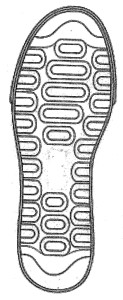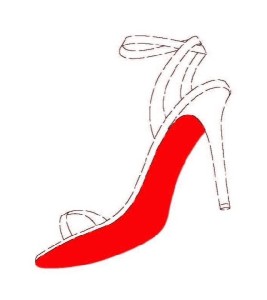Denmark: 3D-marks – so desirable and yet so hard to get
Lately, there have been four interesting 3D-cases in Denmark based on absolute grounds.
The first case is a decision by the Danish Board of Appal (hereafter called DBoA) which related to an application by Christian Louboutin for the following 3D mark under application number VA 2013 01135.
The Danish Patent- and Trademark Office (hereafter called DKPTO) rejected the application as they found the mark non-distinctive for high heel shoes. Surprisingly, the applicant chose not to file evidence showing that the mark had acquired distinctive character through use (which most likely would have changed the outcome) but only argued for distinctiveness per se. In it’s appeal to DBoA the applicant – more or less – repeated the arguments filed with the DKPTO, and the decision was upheld.
To “reality-check” this out-come I made a search in EUIPO’s database and found that the identical 3D mark was already registrered as an EUTM, as back in 2010 the Second Board of Appeal (hereafter called EUBoA) chose to reverse the decision of the examination department and decided to register EUTM 8845539. The applicant filed material showing use of the mark but did not invoke EUTMR Article 7(3). The 3D mark was registrered as the EUBoA found the mark distinctive per se as the “colour red Pantone No 18.1663TP applied to the sole of a high-heeled shoe …departs significantly from the norm or customs of the sector”. The argumentation of EUBoA for the distictive character of the mark continues to refer to the material showing use of the mark although the applicant has not claimed protection under Article 7(3) EUTMR.
I believe this example must be the exception to the rule as it is my impression that the practice at EUIPO tends to be more strict in relation to 3D marks than is the case in Denmark. In the near future we can expect that the CJEU elaborates on the issue as a request for a preliminary ruling from the Rechtbank Den Haag (Nederland) was lodged on 21 March 2016 — Christian Louboutin, Christian Louboutin SAS v Van Haren Schoenen BV (Case C-163/16). Let us hope that they will come to the same conclusion as in the US-case Louboutin v. Yves Saint Laurent, US Court of Appeals for the Second Circuit, 11 Sep 2012.
An example of where practice in Denmark and at the EUIPO appears to be in line is the rejection of VA 2006 04641/EUTMA 5529243 applied for by New Balance Athletic Shoe, Inc. Both DKBoA and EUBoA found that consumers, in the absence of any logo or distinctive figurative  element, would not perceive the sole of a shoe as a sign of trade origin. Both Boards found that the trademark applied for taken as a whole, and considering all its design aspects, is insufficient to inherently act as a sign capable of distinguishing the applicant’s goods from those of competitors. On the contrary, it would be seen by the relevant consumer merely as another type of sole. Although buyers of athletic shoes at the top end of the market may indeed take into consideration the nature of the grip and the design of the sole, they would nevertheless be unlikely to consider it, in isolation, an indication of trade origin without being educated to do so through e.g. advertising or significant market exposure. However, no such evidence was filed by the applicant. Both Boards concluded that in the absence of other effects such as a device or logo, the mark as applied for did not possess the power to distinguish the goods in question from those of other competitors.
element, would not perceive the sole of a shoe as a sign of trade origin. Both Boards found that the trademark applied for taken as a whole, and considering all its design aspects, is insufficient to inherently act as a sign capable of distinguishing the applicant’s goods from those of competitors. On the contrary, it would be seen by the relevant consumer merely as another type of sole. Although buyers of athletic shoes at the top end of the market may indeed take into consideration the nature of the grip and the design of the sole, they would nevertheless be unlikely to consider it, in isolation, an indication of trade origin without being educated to do so through e.g. advertising or significant market exposure. However, no such evidence was filed by the applicant. Both Boards concluded that in the absence of other effects such as a device or logo, the mark as applied for did not possess the power to distinguish the goods in question from those of other competitors.
The third example went all the way up to the third (and final) instance in Denmark. Hultafors Group AB applied for trademark registration of VA 2011 00774 in Class 9 for measuring instruments, namely rules.
Group AB applied for trademark registration of VA 2011 00774 in Class 9 for measuring instruments, namely rules.
DKPTO rejected the mark as non-distinctive on grounds corresponding to Article 7(1)(b) EUTMR. The applicant filed evidence showing use of the mark e.g. a market survey covering the market for professional users but excluding the market for private consumers (which corresponds to approximately 10 p.c. of the applicant’s sales in Denmark). The evidence showing use of mark was rejected as insufficient as private consumers were not included in the survey. The DKPTO found that it is not possible to transfer the results for the professional consumers to the private consumers, as the level of attention of private consumers is deemed to be lower.
The rejection of the 3D mark was upheld at DKBoA and the Maritime and Commercial High Court for more or less the same reasons. The applicant has asked the Appeals Permission Board to let the Supreme Court rule on this case too.
Very ra rely the DKPTO rejects a 3D mark on the grounds that the shape or another characteristic of the goods is necessary to obtain a technical result (corresponding to Article 7(1)(e)(ii) EUTMR) but DKPTO did so in VA 2013 01953 applied for by KNUDSEN KILEN A/S in Class 19 for wedges. DKPTO argued that the shape of the trademark is necessary to obtain a technical result and (almost) all parts of the trademark applied for (and the technical result) are described in the applicant’s expired patent. Please see R1526/2008-2 “Rubik’s cube” by Seven Towns for a better understanding of the criteria under Article 7(1)(e)(ii) EUTMR.
rely the DKPTO rejects a 3D mark on the grounds that the shape or another characteristic of the goods is necessary to obtain a technical result (corresponding to Article 7(1)(e)(ii) EUTMR) but DKPTO did so in VA 2013 01953 applied for by KNUDSEN KILEN A/S in Class 19 for wedges. DKPTO argued that the shape of the trademark is necessary to obtain a technical result and (almost) all parts of the trademark applied for (and the technical result) are described in the applicant’s expired patent. Please see R1526/2008-2 “Rubik’s cube” by Seven Towns for a better understanding of the criteria under Article 7(1)(e)(ii) EUTMR.
_____________________________
To make sure you do not miss out on regular updates from the Kluwer Trademark Blog, please subscribe here.



